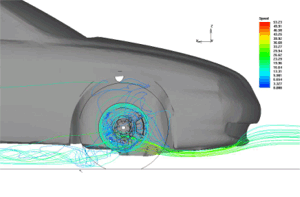
Improving Brake Feel
Improving Brake Feel
Travel loss is how much pedal movement occurs before the vehicle begins to slow. Travel loss is measured at the connection to the vacuum booster (power assisted brakes) or the master cylinder pushrod (non-power assist). Travel loss and the associated pedal feeling consists of the following, keeping in mind that any travel loss is multiplied by the pedal ratio that is specific to your car’s braking system:
Precision-fit between the brake pedal pin and booster push rod. This portion of travel loss can unfortunately be quite a bit for systems that use a brake light switch that is mounted at the pedal linkage. The reason for the large amount of travel loss with a brake light switch on the pedal is due to the allowance of a significant amount of brake pedal travel prior to activating the switch.
Feel can be improved here by reducing the loose fit at the pedal pin connecction.
- Slack in the brake pedal assembly. A test for this slack is done by pumping the brakes until hard (power assisted), then move the pedal by hand to feel its slop movement. If not power assisted, simply push the pedal to its stopping point and move the pedal to check for slop.
Feel can be improved here by inspecting the pedal system for looseness in the pivot points & appropriately repairing the slop. Usually worn bushings are the culprit here. Or, improved bushings (e.g. substitute bronze for original plastic) can be installed.
- Body structure flex. The hard points where the pedals and vaccuum booster mount to the body can sometimes, depending on vehicle structure rigidity, allow for significant deflection under hard braking as a result of the heavy pedal input by the driver.
Feel can be improved here by reinforcing the body structure to better support the pedals and/or booster mount
- Travel loss in vaccuum booster itself. Incidentally this travel is built-in by design to allow for booster expansion due to seasonal temperature variation and the usage of the booster (wear). This travel loss is a very small amount (approx. a couple hundredths of an inch) x the pedal ratio
Improving the feel here is difficult. The booster could be eliminated by installing a mechanical link. However, the pedal effort to stop the car at a high rate can substantially increase. Honestly, the travel loss here is a miniscule amount and may not be worth the effort to eliminate the booster.
- Booster structure stiffness. The variation in stiffness between manufacturers is quite high and therefore the travel loss can be a significant contributor.
Improving the feel is simple. Remove or replace with a high quality booster.
- Master Cylinder (“MC”) precision. The quality of master cyls. can vary quite a bit. Economy re-man MC units aren’t what you’re looking for, to establish good pedal feel. Quality brand name units like Tilton, Wilwood, Ate, et al. are built to high standards and their tight tolerances reduce travel loss. A minimum loss of approx. 1.5mm is required for proper and safe
MC operation. Once again, travel loss is multiplied by the pedal ratio and this loss can be felt at all times.
Improving the feel is simple. Remove or replace with a high quality MC.
- Flexible brake hoses. These hoses connect the solid brake lines from the master cylinder to the suspension and/or brake calipers. Most OEM reinforced rubber hoses can swell/expand quite a bit under the high pressure applied during heavy braking. This hose expansion occurrence increases pedal travel and also reduces pedal feel or sensitivity.
Improving the feel requires hose replacement. Teflon-lined hoses with strong hose reinforcement & braided stainless steel protective sheathing actually do provide a considerable amount of swell reduction and thereby greatly affect the feel of the brakes. The improvement in feel can be felt nearly all the time with the improved flex hoses.
- Brake Caliper Piston Retraction. Often this occurrence is a major contributor to poor brake feel in terms of excessive pedal travel. Piston retraction is the amount of piston return that occurs when
the brake pressure is removed as your foot comes off the brake pedal. The piston can retract quite a bit to create a gap between the piston and pad backing plate (or pad friction material and rotor friction surface). With a relatively large piston gap and several pistons in the entire braking system, piston retraction can create a considerable amount of travel loss. This travel loss is felt at all times.
Improving the feel can be done in a tricky sort of way. Prior to installing brake pads into the caliper assembly, the caliper pistons should be set to a resting position that requires forceful installation of the pads. By establishing this force-fit, you are effectively eliminating the gapping between the pistons and pads
- Caliper Flex. The brake caliper itself can literally flex its shape due to the loads placed on it by the hydraulic pressure of the piston(s). This flex is a function of the caliper material stiffness and it’s structural design- bolted vs. monolithic, one-piece vs. multi-piece, forged vs. cast. Caliper flex is felt during heavy braking events.
The only way to improve the feel here is to replace flexy calipers with high quality stiff calipers.
- Brake pad backing plate. Similar to the caliper flex, the hydraulic force applied by the pistons can flex the brake pad if it is backed with a weak material. The backing plate flex will be felt in the brakes and induce more travel loss. High quality pads are the fix.
- Brake pad friction material. Economy pads often use binders and fillers that allow the pad material to literally compress and shift when applying the brakes. High quality pads are the fix.
Look for a better brake pad for all Alcon applications here:
Above all else, using a quality brake fluid of the proper DOT specification and elimination of air in the brake system via a proper fluid flush is the first step in improving brake feel. Air in the system far exceeds travel loss caused by the aforementioned fixes.
Need to bleed your brakes because of air, mositure, or age?? Here are the fluids we recommend.
It’s also worth noting that installing a pedal assembly with a lower pedal ratio will improve travel loss. Remember, that all travel loss is amplified by the pedal ratio. Therefore a lower ratio will result in a lower total amount of travel loss. The downside to a lower pedal ratio is it requires more force applied at the pedal. So one should expect a noticeable increase in the effort required to stop the car, if a pedal assembly with a lower ratio is installed.


